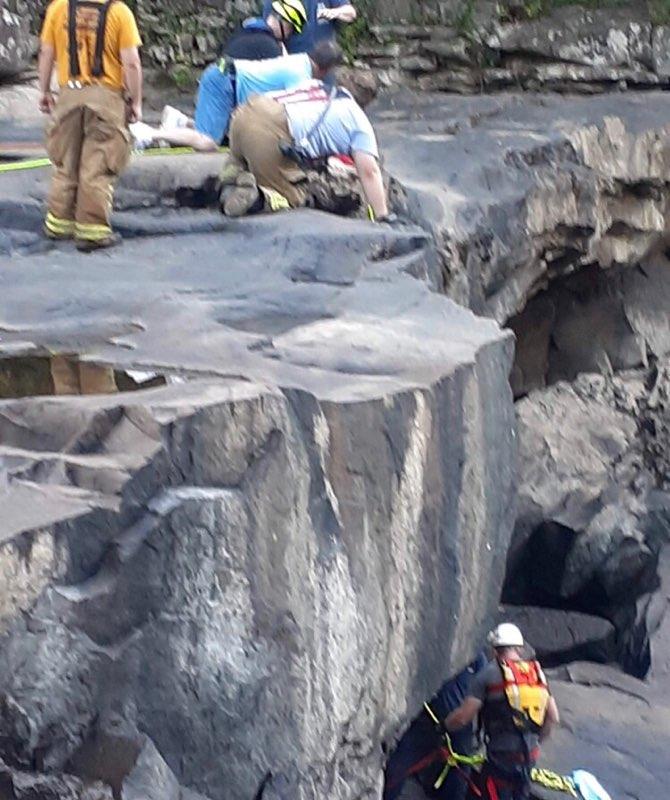With new state-of-the-art equipment being purchased with recent grant funds, the Mountaineer Area Rescue Group (MARG) will be prepared for rescues on even the toughest terrains, allowing the search-and-rescue group to better serve the region.
The $14,500 grant from the Antero Foundation is one of the largest single contributions to the non-profit in its history, according to MARG President Lee Fuell. The money will be used for capital improvements to MARG’s wilderness patient care and backcountry technical rescue capabilities.
“We feel that this is the perfect opportunity for the Antero Foundation to support the selfless mission of MARG,” said Al Schopp, Antero Foundation president. “MARG and this equipment could truly be life-saving for one of our landowners, employees, or community members should they need it while they are enjoying the great outdoors in north-central West Virginia.”
Fuell said the equipment they will purchase with the funds will be some of the best in the industry and the first of their kind in this region.
One piece of equipment Fuell said MARG will be purchasing is an ultralight titanium stretcher with an all-terrain tire designed to be used where there are obstacles or other hazards, like confined spaces, on slopes and in wooded terrain.
The stretcher, known in the industry as a litter, will help to safely transport patients from places inaccessible to ATVs or other vehicles and will also include components to manage hypothermia, appropriately stabilize injuries to the neck and back, and rigging to allow for it to be lifted vertically up cliff faces.
According to Fuell, the group will also add another major tool known as an artificial high directional (AHD) tripod, which is a specialty rope rescue device.
The AHD is a portable system that can be assembled at the site of a rescue and will allow team members to more effectively hoist patients over the edges of cliffs or rig ropes across ravines.
“With the stuff we are getting, the devices are more positionable, we can configure them in multiple different ways, we can actually lean them out over a ledge and tie them back with guidelines or just set them up as a three-legged tripod, so it gives us a whole lot more flexibility.”
Fuell said the new equipment will be used mainly in “high-acuity, low-occurrence type situations.”
He estimated that MARG runs into situations where they absolutely have to have something like the AHD about once a year, but noted the equipment will also be useful in making other rescue scenarios easier and safer.
“We can certainly do rescues now on sloping ground and stuff,” he said. “But if that ground is wet, or if it’s very rubble-strewn, or something like that, this new gear will make it easier for us to get the litter up off the ground so we don’t have to worry about obstructions or people carrying it and slipping and falling.”
Fuell said without equipment like the kind they are purchasing there are usually work-arounds they have done in the past, but they take longer and require more intensive manpower.
“So, we will be able to get things done faster and with fewer people without having to call for additional resources and wait for more people to get there — those are the kind of improvements we are looking at here.”
Without this type of equipment, additional resources from neighboring areas like Bridgeport — which Fuell says has comparable capabilities — cannot always be counted on to be able to lend assistance quickly.
“First of all, it’s an out-of-area, mutual-aid request for them,” Fuell explained, “so they would have to consider whether they could leave their area for what could extensively be a 6- to 10-hour operation, leaving their city uncovered, so that would be part of the situation.”
There are other agencies in the area that have other older-generation, less-capable tripods, but Fuell said with the new equipment MARG will not have to accept a less-capable solution to the problem.
“These resources will greatly enhance our team’s ability to access, treat and extricate patients from the wilderness,” he said. “Combined with our new partnership with Monongalia Emergency Medical Services (EMS), we will be able to bring the full spectrum of EMS care all the way to remote patients, then bring them to definitive care more effectively and efficiently.”
Because the equipment is so specialized, it is made-to-order, which means MARG will have to wait a few months before it arrives.
Currently MARG’s goal is to have staff trained and be fully operational with the new gear by spring 2023, when the outdoor recreation season begins.
For more information on Mountaineer Area Rescue Group and the work they do visit its website, www.wvmarg.org
TWEET @DominionPostWV





